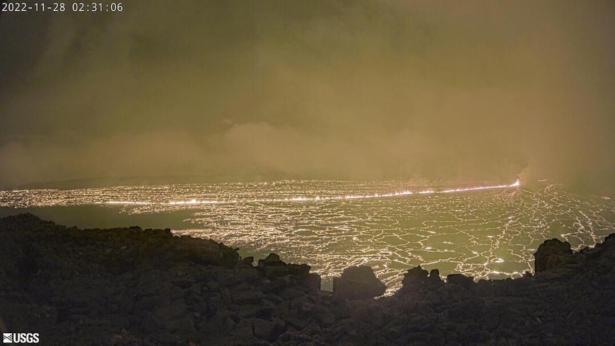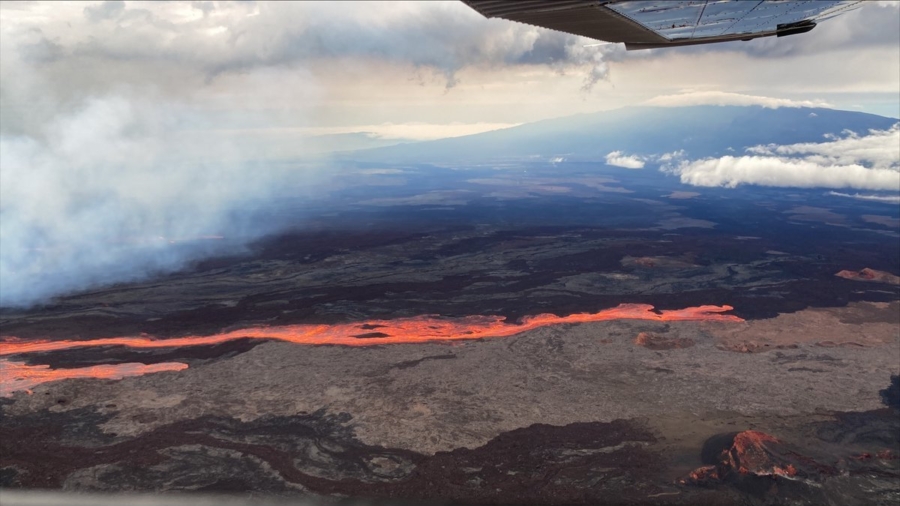HONOLULU—The world’s largest active volcano spewed some ash and lava Monday and officials warned residents of Hawaii’s Big Island to prepare for the possibility of a larger eruption.
Predicting volcanic eruptions is an inexact science. The U.S. Geological Survey warned the island’s 200,000 residents that an eruption of Mauna Loa “can be very dynamic, and the location and advance of lava flows can change rapidly.”
The eruption began late Sunday night in the summit caldera of the volcano on the Big Island following a series of closely spaced, fairly large earthquakes, said Ken Hon, the scientist-in-charge at the Hawaiian Volcanos Observatory. Magma moved to the surface, although lava flows were contained within the summit area and weren’t threatening nearby communities.
Most of the people on the island live in the city of Kailua-Kona to the west of the volcano, which has about 23,000 people, and Hilo to the east, with about 45,000. Officials were most worried about several subdivisions about 30 miles to the south of the volcano, which are home to about 5,000 people.
A time-lapse video of the eruption from overnight showed molten lava lighting up the caldera, moving across it like waves on the ocean.
The eruption migrated from the summit to the northeast rift zone, a notice from the U.S. Geological Survey said. It was feeding several lava flows, which were not threatening any downslope communities.
All indications pointed to the eruption staying in the northeast hazard zone, the USGS statement said.
An eruption from the northeast rift zone could send lava toward the county seat of Hilo or other towns in East Hawaii. It could take lava weeks or months to reach populated areas on this side of the mountain. A rift zone is where the mountain is splitting apart and the rock is cracked and relatively weak—making it easier for magma to emerge.
“We don’t want to try and second guess the volcano,” Hon said. “We have to let it actually show us what it’s going to do and then we inform people of what is happening ASAP.”
“At this time, it’s not a time to be alarmed,” Big Island Mayor Mitch Roth said.
Hawaii County Civil Defense announced it has opened shelters in Kailua-Kona and Pahala because it has reports of people self-evacuating along the South Kona coast.
The average Mauna Loa eruption is not typically prolonged, lasting a couple of weeks, Hon said.
“Typically, Mauna Loa eruptions start off with the heaviest volume first,” Hon said. “After a few days, it starts to calm down a little bit.”

The USGS warned residents at risk from Mauna Loa lava flows to review their eruption preparations. Scientists had been on alert because of a recent spike in earthquakes at the summit of the volcano, which last erupted in 1984.
Portions of the Big Island were under an ashfall advisory issued by the National Weather Service in Honolulu, which said up to a quarter-inch of ash could accumulate in some areas.
Mauna Loa is one of five volcanoes that together make up the Big Island of Hawaii, which is the southernmost island in the Hawaiian archipelago.
Mauna Loa, rising 13,679 feet above sea level, is the much larger neighbor of Kilauea, which erupted in a residential neighborhood and destroyed 700 homes in 2018. Some of its slopes are much steeper than Kilauea’s, so lava can flow much faster when it erupts.
During a 1950 eruption, the mountain’s lava traveled 15 miles to the ocean in fewer than three hours.
Tourism is Hawaii’s economic engine but Roth predicted few problems for those on vacation during the eruption.
“It will be spectacular where it is, but the chances of it really interrupting the visitor industry—very, very slim,” he said.
For some, the eruption might cut down on some travel time, even if there is more vog, or volcanic smog caused by higher sulfur dioxide emissions.
“But the good thing is you don’t have to drive from Kona over to Hawaii Volcanoes National Park to see an eruption anymore,” Roth said. “You can just look out your window at night and you’ll be able to see Mauna Loa erupting.”
By Caleb Jones

